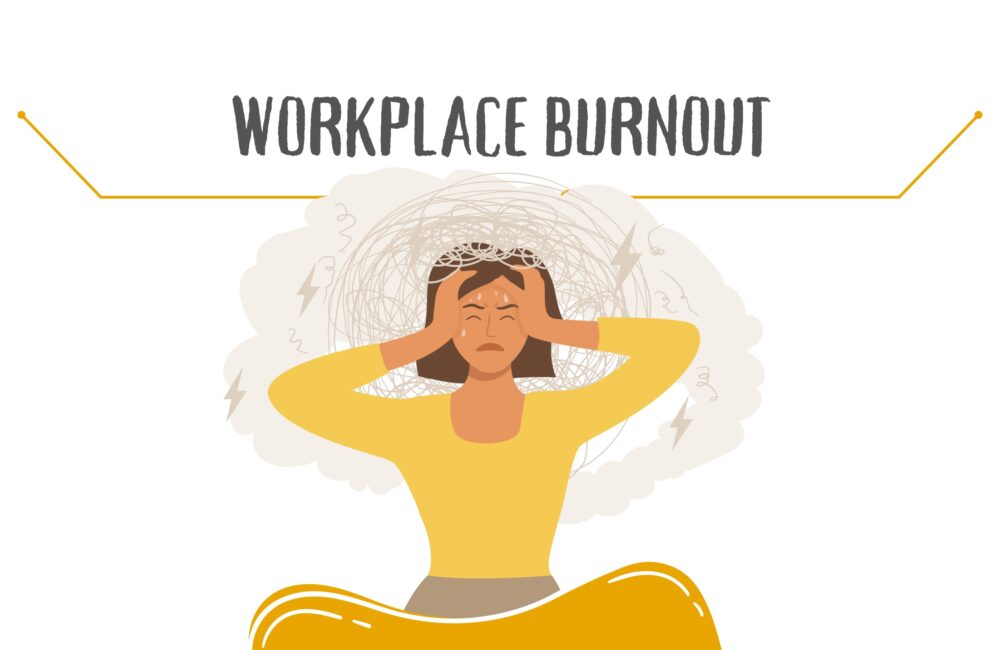Workplace burnout is now an all-too-common phenomenon, impacting not just employees but also workplace culture and business. The evolving corporate ecosystem is a demanding and competitive one, with companies going to any lengths for an edge. It is the employee who bears the brunt of such a challenging situation, falling prey to physical, emotional, and mental exhaustion resulting from prolonged stress and overwork. Employee burnout may not be a medical condition. Nevertheless, its impact on individuals and organizations is profound. In this article, we explain the causes and symptoms of employee burnout and strategies to prevent workplace burnout.
Understanding Workplace Burnout
According to WHO data in 2016, it was found that working 55 or more hours a week increases someone’s risk of a stroke by 35% and dying from ischemic heart disease by 17% compared to working 35 to 40 hours per week. It also found how overwork was causing the deaths of 745,000 people annually. Workplace burnout, characterized by exhaustion, develops gradually and can affect anyone in an organization. Moreover, employee burnout, defined by the WHO as an “occupational phenomenon, is considered a long-term condition with negative long-term consequences for an employee’s mental and physical health. There are usually three facets of burnout in workplace:
- Emotional Exhaustion: The feeling of being emotionally drained and experiencing intense mental stress.
- Depersonalization: Distancing yourself from colleagues and clients, experiencing a sense of detachment, avoiding meetings, and being unsocial towards colleagues and people.
- Reduced Personal Accomplishment: A sense of non-achievement, possible imposter syndrome, lack of self-esteem, and incompetence

Causes of Workplace Burnout
There are many causes of burnout in the workplace, the most common being long working hours. Ironically, burnout can be experienced most by employees who love their work and are driven by a sense of purpose. Research has found that engaged employees face even more stress and are prone to poor mental well-being. Workplace burnout doesn’t have a single cause. It is usually the result of a combination of factors. Here are some of the most common reasons:
Excessive Workload
One of the primary contributors to burnout is an excessive workload. When you’re constantly overwhelmed with too many tasks, deadlines, and responsibilities, it’s easy to become emotionally and physically exhausted. Working too many hours over and beyond your mental and physical capacities will also lead to eventual burnout.
Lack of Control and Limitations
Lack of autonomy and control over work and schedules can be extremely frustrating. It can lead to a sense of helplessness and, ultimately, burnout. Some examples of workplace limitations employees face are:
- Limited control of environment and schedule
- Limited participation in decision-making
- Lack of clarity in their work
- Poor communication with management
- Lack of recognition
- Lack of resources results in inefficient projects
Poor Work-Life Balance
A healthy work-life balance is essential to mental well-being. If your work constantly infringes on your time, it can lead to burnout. Moreover, it also leads to the stress and anxiety of not spending ample time with family.
Toxic Work Environment
One of the biggest work stressors, a toxic work culture, including bullying and harassment or lack of support, can be a significant source of stress and burnout.
Sign of Workplace Burnout
Some definite signs and symptoms show an employee may be suffering from burnout, such as poor sleep, headaches, irritability, or stress. These can also impact work quality and productivity and be detrimental to an organization that fails to attempt to remedy the phenomenon. Here are some common signs of workplace burnout:
- Chronic Fatigue and exhaustion
- Lack of sleep
- Headaches and migraines
- Poor appetite
- Irritability and anxiety
- Being cynical towards colleagues
- Detachment and no interaction
- Poor concentration and quality of work
- Easily emotional
- Lack of motivation
- Stress and depression
- Reduced creativity
- Absenteeism
How to Prevent Burnout in the Workplace
Dealing with workplace burnout is not only beneficial for employees but also for organizations. It can lead to increased productivity, higher morale, and reduced turnover rates. Here are some strategies to prevent burnout:

1. Set Realistic Goals and Priorities
When employees are deputed with achievable goals with more work clarity on project priorities, it helps in managing workloads effectively and reducing stress. There is no room for doubt, and the employee knows what is expected of them. It also allows an employee to achieve work-life balance.
2. Breaks and Time Off
Office managers should be observant and compassionate enough to understand when an employee needs a break and some time off. This is especially valid for high-performing employees whose contribution to the business is essential. Signs that one needs a break are simple things like typo errors or physical problems like eye strain or headaches. Encouraging breaks benefits work culture in the long run and does not make an employee feel guilty that they may be neglecting their duties.
3. Create a Healthy Working Environment
Employees who are supported find it easier to communicate their feelings. When people are given opportunities to express their emotions and feelings, they find it easier to let go of them. This prevents the pent-up negativity from causing physical, psychological, or emotional harm, leading to reduced chances of burnout. Additionally, a culture of respect, cooperation, and addressing toxic behavior can do much to improve employee well-being.
4. Promote Work-Life Balance
Support a healthy work-life balance by discouraging excessive overtime and ensuring employees take their vacation days. Please encourage them to disconnect from work when they’re off the clock. It’s all well and good for an employee to want to put in more hours, but that should always be according to mental capabilities. Ideally, spending time at home with family or friends is just as important for mental well-being as dedication to work.
5. Employee Recognition
One of the most compelling ways to induce positivity and motivation in an employee is by acknowledging their skills and recognizing the efforts of their work. Regularly acknowledge and reward employees for their actions and achievements. Recognizing their contributions can boost morale and motivation.
6. Employee Assistance Programs
EAPs (employee assistance programs) or even ERGs (employee resource groups) are helpful in providing employees access to mental resources such as counseling and stress management to help them cope with personal and work-related challenges. This needs a good human resource team well trained in stress management and burnout to understand employee welfare.
Workplace burnout is now a serious issue that needs addressing for the health of human resources as well as the organization. Organizations should support employees in their professional development by adopting strategies that foster a positive work culture to create a more productive and satisfying work environment.
















